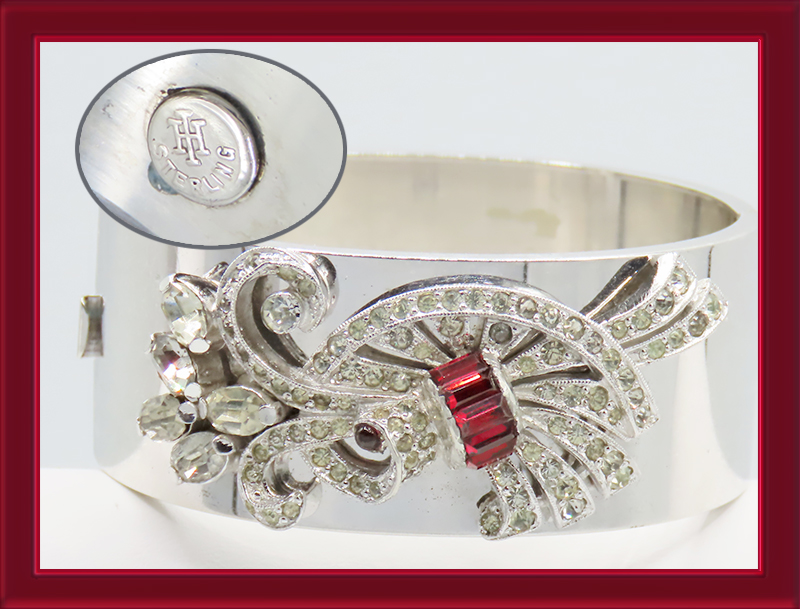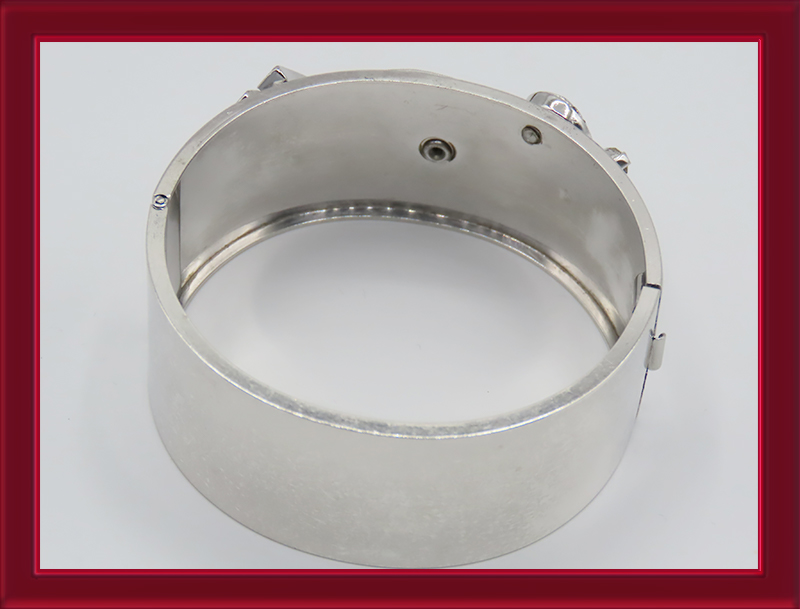Return To Previous Page
Iskin | Art Deco Hinged Cuff Bracelet
Iskin | Art Deco Hinged Cuff Bracelet
. . . . Bold Elegance!
Harry Iskin
Instead of trying to recreate the style and fashion at its bold Roaring Twenties peak, slip your wrist into this circa 1930s Iskin sterling cuff bracelet. A very wise choice. The mirror-like shine of sterling mimic’s platinum and the crowning jewel cluster mimic’s diamonds and rubies. They both certainly do as intended—even today.
When slipping your wrist into this stunning bracelet you can’t help but wonder who wore this originally. No doubt someone with great style. The bracelet has a tab closure which gives a sound click when closing. The sterling is in very good condition especially for its age. My wrist is about 6 1/2 inches and I have no problem with the size, but I will warn that when wearing this beauty it can be a bit tight because of its width and how it falls on the wrist.
The connection between culture and design is amazingly apparent when studying the design style of so many designers who are responsible for the vintage pieces we covet today. The roaring ’20s, a mixture of “bold” and “opulent”, which is a representation of its time period, makes for a striking aesthetic that’s easy to recognize. ID-304
Measurements:
Bracelet — Fits wrist size of 6 ½"
Iskin Jewelry History —
Harry Iskin was born in London, England on September 30, 1886. His parents were both born in Russia. He immigrated to the United States and became a U.S. citizen in 1908 at the age of 22. He married his wife Leah in 1911. She and her mother were both born in Pennsylvania, her father was British.
In 1917, Harry registered for the World War I draft. He lived in Philadelphia and listed his occupation as a jewelry engraver. His first child, Evelyn, was 4 years-old. The draft card listed his physique as “slender, medium build, gray eyes, and brown hair.” In 1920, his second daughter Pauline was born. In 1930 his occupation was a manufacturer of wholesale jewelry.
In 1936 he moved to more spacious quarters in Philadelphia to accommodate his growing business. In 1938 he rented additional “business quarters” on the west side of Manhattan (NYC) as Iskin Manufacturing Company. The December 28, 1953 issue of The New York Times classifieds listed an auction notice. It was for a “Receiver’s Sale in Bankruptcy in the matter of Iskin Manufacturing, Company, Inc. All stock, supplies, machinery, and equipment were auctioned on the company’s premises in Philadelphia on January 6, 1954.
Mr. Iskin’s last address was in Montgomery, Pennsylvania where he died at age 82 in April, 1968. In summary, Mr. Iskin’s jewelry talents were employed as early as 1917 and he was a jewelry manufacturer for at least 23 years, from 1930 through 1953. He was based in Philadelphia, with an additional location in New York for a time.
Most of the Iskin jewelry available is gold filled, sterling, or vermeil. Yellow gold was used on the entirety of a piece, with rose gold used as a contrasting accent. A common brooch theme is a floral design, with limited use of glass stones, embellished with any or all of the following: bars or pleats, curlicues, ribbons, and leaves. Some designs are more simple and dainty, while others are more ornate. The brooches range in size from one to four inches in height. He also made link bracelets, earrings, and necklaces. Stone colors seem to cover the rainbow and include topaz, pink, red, lime, green, shades of blue, purple. Pearls were also used.
More rare are rhinestone brooches and hinge bangles (and whatever else there is to discover!). I’ve seen three examples of a framed brooch, constructed similarly like a Coro Duette. The frame has three prongs to which a small brooch and a pair of earrings are attached. Another form has one larger pin and two scatter pins on a three pronged frame. My example is marked “Iskin Pat. App.”, and I’m searching for another example in the hopes that it has a patent number.
Sources:
Social Security record on Ancestry.com
1930 Census, City of Philadelphia, PA
Draft Registration card (WWI), dated June 5, 1917
New York Times, October 12, 1938
New York Times, December, 28, 1953
Jewelers Circular Keystone, August 1936
Collectors Weekly: Carolyn Davis, Harry Iskin Jewelry — Researching Costume Jewelry: [https://www.costumejewelrycollectors.com/vintage-costume-jewelry-research/designers-manufaturers-and-styles/jewelry-manufacturers/harry-iskin-jewelry/]: [1997]
Having trouble with the small sizes of
yesteryear? Well, most of us do!
The ladies were smaller than the women of today.
NO Problem, be sure to check out our necklace extenders.
The ladies were smaller than the women of today.
NO Problem, be sure to check out our necklace extenders.




